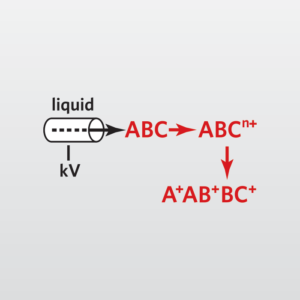Liquid Chromatography Mass Spectrometry (LC-MS)
Home » Our Techniques » Mass Spectrometry » LC-MS
Liquid chromatography-UV-mass spectrometry (LC-UV-MS) is an analytical chemistry technique for identification, quantitation and mass analysis of materials.
Liquid chromatography is often referred to as HPLC (high performance liquid chromatography), or UPLC (ultra high performance liquid chromatography). A pump is used to provide a continuous flow of a solvent into which a dissolved sample is introduced. Analytes within the dissolved sample are then separated based upon their intrinsic affinities for both a “mobile phase” (typically a buffered solvent) and a “stationary phase” (porous solid support with specialized coating). After the analytes are separated on the column, they pass through a UV detector and into a mass detector.
The mass detector can be equipped with probes to perform either electrospray ionization (ESI) or atmospheric pressure chemical ionization (APCI). Both ESI and APCI are similar in that the ionization of the analyte(s) of interest occurs at atmospheric pressure. APCI is more effective than ESI with non-polar species in specialized circumstances, as the collisions with the reactive gas may provide the molecule with a charge.

For common circumstances, ESI nebulizes the sample producing ions that are either positively or negatively charged. Minimal (or no) fragmentation occurs, allowing for determination of the molecule’s molecular weight.
Once the parent ions are produced, they may be trapped using an ion trap (IT) and subjected to further fragmentation experiments, the number of which depends on the concentration of the analyte. For each experiment, fragment ions specific to the parent ion are be observed and can provide valuable information about the compound of interest.
As an additional option, EAG can perform LC tandem MS (LC-MS-MS) experiments with customized method development. Instead of being trapped using an ion trap as discussed above, ions migrate through a series of mass analyzers undergoing exclusion and fragmentation (also referred to as MS2) for highly sensitive and selective mass analysis using a triple quadrupole MS, an Orbitrap MS or a Q-TOF MS.
For both UV and MS responses, the measured peak area or height is concentration-dependent and may be used to quantify the component.
Ideal Uses of LC-MS
- Medical device chemical characterization via ISO 10993:18
- In-line UV detection allows for the same or similar capabilities as HPLC and UPLC
- Analysis of ionizable compounds (usually polar) lacking UV-chromophores
- Structural information and confirmation, using MS/MS to produce product ions from precursor ion (analyte of interest)
- Qualitative and quantitative analysis of the following example analytes:
- Surfactants/emulsifiers
- Polyethylene glycol (PEG)
- Polypropylene glycol (PPG)
- Ethoxylated and propoxylated analytes containing fatty alcohol, fatty acid, and other headgroups
- Sodium lauryl/laureth sulfate
- Alkyl benzene sulfonates
- Trade Name Materials: Brij, Span, Tween
- Biocides/preservatives
- Quaternary ammonium chloride compounds (QACs)
- Benzalkonium chloride (BZK)
- Polyquats
- Quaternary ammonium chloride compounds (QACs)
- Polymer extractable/leachables
- Stabilizers/Antioxidants (e.g. Irganox)
- Irritants/Sensitizers
- Plasticizers
- See whitepaper for example: Will the Newest Wearable Device Leave You Itching for More?
- Dyes
- Pesticides
- Other ionizable compounds (usually polar) that may contain certain functional groups (esters, sulfates, phosphates, ammonium, ethoxylate, propoxylated)
- Surfactants/emulsifiers
- Analyses are possible for analytes in a complex matrix and/or at trace levels
- Sample matrix examples:
- Pharmaceutical (i.e. cream, gel, ointment, shampoo, oral suspension, ophthalmic suspension, tablet, capsule, softgel)
- Environmental (i.e. soil, water, sediment)
- Biological (i.e. crops, livestock tissues, milk, eggs, blood, urine)
- Industrial (i.e. packaging, cleaning products, chemical products, raw materials)
- Food (i.e. beverages, fruits, vegetables meat products, baked goods, and other processed sources)
- Other surfaces (i.e. electronics)
- Through method development, existing methodology can be updated for greater specificity and sensitivity using a triple quadrupole mass spectrometer (MS/MS)
- Direct injection (infusion) MS (no LC separation) analysis available as an alternative approach
Strengths
- LC (both reverse and normal phase) affords great range of chromatographic separation options
- Provides both identification and quantitative information
- Enhanced mass resolution (QE and Q-TOF) allowing for structural elucidation
- Ability to monitor both positive and negative ions during a single run (IT)
- High specificity of detector. No need for confirmatory detection method (MS/MS)
- High sensitivity. Can detect some compounds in the parts-per-billion and -trillion ranges (MS/MS)
- Excellent reproducibility when stable labeled internal standards are available (MS/MS)
Limitations
- Compounds must be soluble in common solvents such as water, alcohols, and acetonitrile
- Compounds must be ionizable, which normally requires the molecular to be polar
- Depending on analyte, reproducibility may be lower when compared to UV detection
- Matrix co-extractants can suppress or enhance ionization potential. May need to employ matrix-matched calibrants for quantitation
Mass Spectrometry Technical Specifications
Mass Ranges
- m/z 50 – 2000
- m/z 200 – 4000
- Larger molecules (> 4000 Da) may be observed as multi-charged ions below m/z 4000
Resolution
- Down to 0.05 FWHM (full width half maximum) with Ultra ZoomScan
- 140,000 resolution at m/z 200 and < 1 ppm mass accuracy provides enhanced ID confidence (QE Orbitrap)
- 60,000 resolution and < 2 ppm mass accuracy (Q-TOF)
Polarity Switching
- 100 msec between positive and negative MS scan power
- MSn for n = 1 through 15
LC-MS Ion Database
EAG Laboratories possesses commercial and proprietary internal databases for a combined database containing over 20,000 entries. In addition, EAG Laboratories utilizes public online databases (e.g. ChemSpider, PubChem) to supplement internal database searching in order to identify unknown compounds. EAG leverages the shared knowledge and expertise of our chemists along with usage of this tool to efficiently screen for impurities, surfactants sensitizers, and irritants.
Related Resources
Would you like to learn more about using LC-MS?
Contact us today for your Liquid Chromatography Mass Spectrometry needs. Please complete the form below to have an EAG expert contact you.